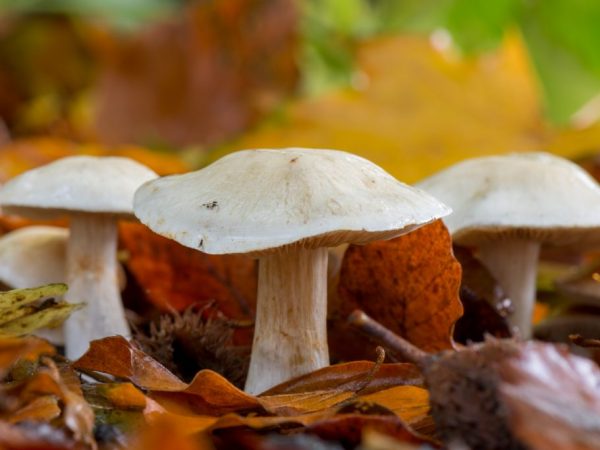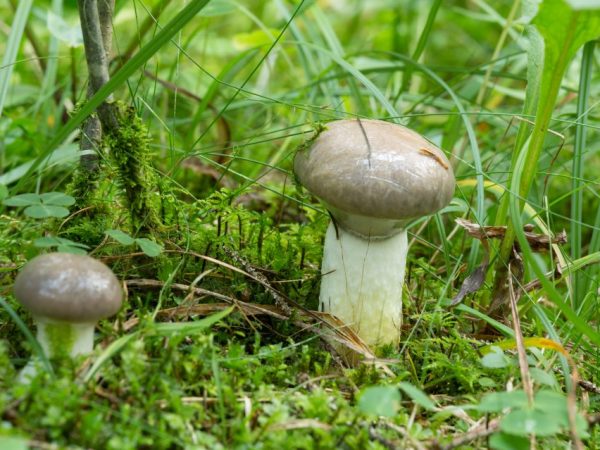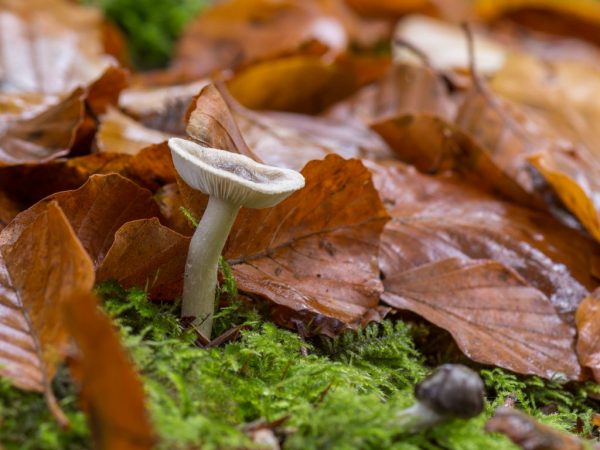Description of the fungus of the genus Gigrofor
The Gigrofor mushroom has unique properties that have a positive effect on the human body. Studying the characteristics of this kind of mushrooms allows you to enjoy their collection and benefit from the use of the harvest.
- Description of appearance
- Mushroom species
- Larch gigrofor
- Early Gigrofor
- Gigrofor late (brown)
- Fragrant gigrofor
- Gigrofor olive-white (sweet tooth, blackhead)
- Gigrofor black
- Gigrofor russula
- Gigrofor beech
- Beneficial features
- Contraindications
- Cooking applications
- Cabbage and mushroom pie
- Mushroom gratin
- Application in medicine
- Growing methods
- Conclusion

Description of the mushroom variety Gigrofor
Description of appearance
The mushroom is a representative of the lamellar group, belongs to the Gigroforov family. Outwardly, it has a convex cap, covered with mucus, of a cream or olive color, with a diameter reaching 5-13 cm. Often the cap has a tubercle in the center. The leg grows up to 3-6 cm and resembles a cylinder in shape. The plates are descending, diverging to the edge of the cap. All species of the genus are mycorrhizal formers. The fungus root is formed with both trees and herbs. There are no poisonous species among the representatives of the genus Gigrofor.
Mushroom species
The genus Gigrofor has about 40 varieties. They grow among trees and grass, forming a joint "root" system, or rather mycorrhiza. The most famous are the following types of mushroom Gigrofor:
- larch;
- early;
- late;
- fragrant;
- g. olive-white (sweet, blackhead);
- g. black;
- russula;
- g. beech.
They grow in spruce, birch places, where a layer of moss prevails. Distributed in Asia, North America, Europe.
Larch gigrofor
The species has a light yellow cap with a diameter of 3-7 cm, with mucus. The leg of this edible species grows up to 3-8 cm in height, is presented in the form of a cylinder and is thickened at the base. The plates are thick, sparse, white-yellow in color.
Larch hygrophor has white or yellowish pulp. The fungus forms mycorrhiza with larch trees, therefore it is most often found under these trees. They are also found in the south of European countries from August to September.
Early Gigrofor
Gigrofor early grows in spring, as soon as the snow melts, so it is quite fair to call it a "snowdrop" mushroom. They grow in small families in last year's foliage, old needles. The usual habitat is coniferous and deciduous forests. Most often found under the beech. Due to such early fruiting, this species has no poisonous twins.
Description of the mushroom:
- the cap is white in a young specimen, there are convex places, with a crookedly wrapped part;
- the pulp does not smell, tender and white;
- the leg is short, fleshy;
- an adult mushroom dries up, turns out to be gray, less often - black;
- white plates, diverging, between them there may be small plates at the edge of the cap.
Early Gigrofor has a pleasant taste; soups and other dishes are prepared from them.
Gigrofor late (brown)
The late hygrophoric fungus begins to grow in the fall and continues to bear fruit until snow falls, reaching small sizes.Gigrofor brown (synonym for the name of the species) is a mushroom hiding in moss thickets, found in large groups. Prefers coniferous and mixed forests. Its common neighbor is pine. This species has a small brown or light brown cap with a smooth surface, its diameter is up to 4 cm. The surface of the cap is slimy even in dry weather, so these mushrooms are popularly called "wood lice". The stem of the fungus is a late brownish hygrophor, thin and long. Despite their small size, these species are edible, which are popular with mushroom pickers.
Fragrant gigrofor

Mushrooms grow in small groups
Fragrant gigrofor is found from late August to November in shady areas where there are spruces and moss. Forms small clusters that, in damp weather, emit a persistent anise-almond aroma.
The cap is gray-brown, gray-green, up to 8 cm in diameter. In young mushrooms it is convex, and in older mushrooms it acquires a prostrate shape with a central tubercle. The pulp is tasteless, loose, smells like anise. The plates are thick (this is clearly visible when viewed even without a magnifying device), soft, and sparse. The color of the plates changes with the age of the fungus: they are whitish in young ones, and gray in old specimens. The leg is light gray with a dense structure, 5 cm high.
Gigrofor olive-white (sweet tooth, blackhead)
Meet the families of the olive-white hygrophor, or as it is also called olive-white woodlice, will turn out in the fall, they form large colonies. The sweet mushroom begins to grow in summer and continues until September-late October. You can find out the olive-white hygrophor by the following description:
- the cap is white and convex, after a while it changes from brown to olive color. It is darker in the center. In mature specimens, it is flat or depressed, with a tubercle in the center. Diameter 2-8 cm;
- the pulp is white, with bitterness, does not smell;
- the leg is high, has the shape of a cylinder. In the upper part, the color is dry, white (above the remnants of the ring) and with whitish pubescence, but in the lower part there is a moire pattern and mucus.
Irina Selyutina (Biologist):
Gigrofor olive-white is able to remove toxins from the body. In addition, the mushroom is also a low-calorie product that can be introduced into the diet with various diets. Its name-epithet "sweet tooth" got its appearance thanks to the sweetish taste of the pulp. On the scale of taste, this species is referred to the 4 taste category. It can be used for food without boiling. However, it is always important to remember that this is only possible for mushrooms collected in ecologically safe places.
By the way. The late hygrophor is similar to the olive-white hygrophor.
In wet weather, mucus appears on the surface. This species is popular among mushroom pickers. Occurs in deciduous forests. but prefers mountain forests.
Gigrofor black
Gigrofor black has the following description:
- the cap is convex, over time it turns into a depressed one, with wavy edges, up to 12 cm in diameter;
- the flesh is fragile and white;
- leg in the form of a cylinder, covered along with grooves;
- the plates are white, wide, sparse; with age, they acquire a blue tint.
The black hygrophor grows in dampness in autumn among mosses, it is a delicacy species, along with porcini mushrooms and champignons. When soaking dry mushrooms, the water from them can be used to prepare various dishes, because minerals from the fruit bodies partially remain in the water.
Gigrofor russula
The russula hygrophor, or as it is also called - cherry, is common in deciduous forests, where it prefers to settle under oak trees. Most often, these mushrooms can be found in hilly or mountainous areas. The hat is burgundy, dark pink, with mucus, 12 cm in diameter, fleshy and strong. The skin is covered with a mass of scales. The pulp is white, does not smell, and turns red on contact with air.The leg is white, dense, grows up to 10 cm.
Gigrofor russula is an edible species.
Gigrofor beech
The beech hygrophor is characterized by a thin elastic cap with a central tubercle, smooth skin, sometimes sticky in dampness. The color of the cap changes as the fungus develops - from white to pale pink. The center of the cap is darker than the edges - ocher or rusty brown. The leg is fragile, in the shape of a cylinder, covered with a bloom, the plates are thin. It belongs to the edible species, it is not very popular due to its small size and volume of pulp. Despite the fact that this mushroom is edible, it is not popular among fans of "quiet hunting" because of its miniature size and a small amount of pulp suitable for food.
Beneficial features
The use of these mushrooms will allow you to establish metabolism, improve the functions of the thyroid gland, digestive, immune systems, and normalize well-being.
The beneficial effects of the hygrophor are as follows:
- normalizes the digestive tract - food is absorbed through the intestinal walls, intestinal motility is normalized, the mucous membrane gains elasticity;
- blood microcirculation accelerates - neutralization of inflammatory processes;
- control of acid-base balance - the lymphatic system works better, wrinkles are smoothed, aging slows down;
- prevents the development of diabetes mellitus;
- improves kidney and liver function;
- tones the body - stimulates metabolism, develops resistance to inflammatory processes;
- helps to fight overweight;
- sedative property - nervousness decreases.
For the composition of the representatives of the genus, the presence of amino acids and vitamins A, C, D, PP and group B is characteristic. The amount of protein is not inferior in this indicator to meat. Also, the presence of sodium, sulfur, potassium, manganese, calcium, iodine and zinc was determined in the composition of the mushrooms.
Contraindications

Mushrooms are not suitable for everyone
Not everyone can eat hygrophors. The fungus is contraindicated in such cases:
- individual intolerance to the components of the hygrophor - it manifests itself in the form of nausea, vomiting, appears: yellowness in the sclera of the eyes, salivation, stomach cramps, the temperature rises, internal hemorrhage may occur;
- pregnancy and breastfeeding;
- epilepsy - headache, nausea, confused thoughts, pressure drops, fever, changes in complexion.
Cooking applications
Hygrophors have a delicate taste. Before cooking, be sure to cleanse it of mucus.
Irina Selyutina (Biologist):
In the world culinary practice, hygrophors are quite popular, in contrast to Russia. When using them, it should be borne in mind that mucus on the surface of the cap, even in the smallest amount, can completely ruin the taste of the dish. Therefore, it must be very carefully cleaned off. TO note. Unlike many other edible species, hygrophors are boiled down much less.
They are used for pickling, pickling, cooking and frying.
Cabbage and mushroom pie
For cooking you will need:
- 250 g minced meat;
- 200 g of mushrooms;
- 700 g cabbage;
- 2 onions;
- 4 eggs;
- 50 g flour;
- sunflower oil;
- greens;
- salt, ground black pepper to taste.
Mushrooms are washed, peeled, boiled for 15-20 minutes in salted water. Chop the onion, fry until golden brown, mix with minced meat, mushrooms, salt, spices. Chop the cabbage finely, add eggs, flour, herbs, salt to it. Put half of the cabbage in the pan, on top of the mushroom filling, then the rest of the cabbage. Fry the cake on both sides until tender. Garnish with herbs before serving.
Mushroom gratin
To prepare mushroom gratin you will need:
- 1 kg of potatoes;
- 500 g of mushrooms;
- 250 g heavy cream;
- 2 eggs;
- 1 onion;
- 20 g mayonnaise;
- 2-3 cloves of garlic;
- salt, spices to taste.
Mushrooms are peeled, washed, fried with onions.Cut the potatoes into small pieces, then spread them in an even layer on the bottom of the baking dish. Put on top (evenly, over the entire surface of the potato) mushroom filling. Filling is done - cream, eggs, garlic, salt, spices, mayonnaise are mixed. It is poured over gratin. In the oven, the dish is baked at 180 ℃ for 60 minutes. Serve cut into portions.
Application in medicine
Gigrofor contains minerals and vitamins necessary for a person. Thanks to its composition, the mushroom is widely used in the treatment of colds and diseases, it successfully relieves inflammation of the upper respiratory tract. Hygrophors have antibacterial, antifungal effects, are used to prepare a strong antibiotic.
Growing methods
Gigrofor will be able to grow at home by sowing mycelium. One package goes for 1 m². "Seeds" are mixed with soil or sand. Planting is carried out under trees at any warm season (spring-autumn), the soil requires digging and loosening to prepare planting depressions.
The mycelium is placed on a loosened area, covered with a layer of forest or garden soil on top. Planting is watered at the rate of 10 l / m². Harvesting is carried out 4 times a year: 2 times in spring and autumn. It will be possible to improve the yield of planting with the help of fertilizers with humus, but not during the growth period.
Hygrophors are also grown indoors, but the yield with this method of cultivation of this mushroom is low.
Conclusion
Gigrofor is a tasty and healthy mushroom. Proper use of its properties in medicine and cooking allows you to get benefits for the body.



